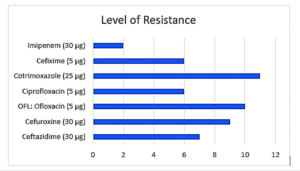Antimicrobial resistance (AMR) remains a critical global health threat, often surfacing first through localized patterns before spreading more broadly. In July, I conducted a focused spatiotemporal analysis of antibiotic susceptibility test data collected from hospitals across Lagos State, Nigeria, to detect emerging resistance trends and support public health response.
The analysis centered on 27 multidrug-resistant (MDR) isolates of Klebsiella pneumoniae obtained from various clinical samples, including urine, blood, feces, wound, and nasal swabs. Among these, I identified a troubling cluster of carbapenem-resistant K. pneumoniae (CRKP) – particularly concerning due to their resistance to imipenem, a last-resort antibiotic in critical infections.
To highlight these findings, I developed an interactive dashboard and analytical tools, which visualized resistance trends across sample types and healthcare facilities. A core component of the dashboard is the bar chart below, summarizing the frequency of resistance to key antibiotics during the July surveillance period.
Key insights from the July data include:
- Cotrimoxazole (25 µg) showed the highest resistance, affecting 11 isolates.
- Ofloxacin, cefuroxime, and ceftazidime also showed widespread resistance.
- Imipenem (30 µg) resistance, although less frequent, signals a dangerous rise in carbapenem resistance, marking a serious threat to treatment options.
- Several isolates exhibited resistance to five or more antibiotics, confirming extensive MDR patterns.
This analysis also supported the development of a structured, analyzable dataset in Excel and an early warning visualization tool for decision-makers. By delivering both epidemiological insight and operational utility, this project contributes to Nigeria’s broader AMR surveillance and control strategy.
By combining spatial mapping, seasonal analysis, and interactive data storytelling, this work underscores the power of localized AMR monitoring tools in informing public health interventions before threats become unmanageable.

Author:
Obianefo Obianuju
Scientific Officer (Microbiologist)
Federal Ministry of Health,
Abuja Nigeria
